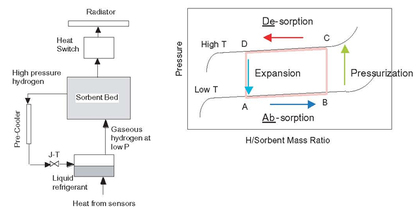Sorption Coolers
Sorption coolers are attractive systems for providing cooling for instruments, detectors and telescopes when a vibration free system with no moving parts is desired. Since the spacecraft's warm end is by design located away (thermally and spatially) from the payload, this allows for excellent flexibility in integration of the cooler to the cold payload (instrument, detectors and telescope mirrors) and the warm spacecraft.

The sorption cooler, shown conceptually in the figure below, consists of a compressor and an expander (the cold end) much like your home refrigerator. The sorption compressor (SCC) absorbs gas at low pressure and releases (desorbs) gas at high pressure after being heated. It is therefore a thermal compressor. By sequencing several sorbent compressor elements, a continuous flow of high-pressure refrigerant is provided.
The refrigerant fluid in the sorption coolers is Hydrogen. Hydrogen was selected because these coolers are designed to operate at a temperature of ~17 K, or -429° F (just 31° F above absolute zero!!). At that temperature hydrogen is a liquid and can "boil" to provide refrigeration.
The compressor is a thermal rather than a mechanical compressor. It uses a metallic hydride (La1.0Ni4.78Sn0.22) to absorb the hydrogen gas at low pressure when approximately at room temperature. When heated, the hydride reversibly releases hydrogen gas at high pressure. Therefore heating the sorbent effectively compresses the gas. This hydrogen storage material technology was developed by JPL and so far offers the most stable long-term reversible hydrogen storage of any metal hydride. The advantages of this material has led others to use it for a variety of purposes which include acting as the "gas tank" in prototype hydrogen cars, as well as storing hydrogen gas isotopes from decommissioned Russian nuclear weapons.
The hydride sorption compressor tends to be very robust since pressurization and absorption of the hydrogen refrigerant uses hydride beds that are simply heated and cooled sequentially with no moving parts. The only caveat to "no moving parts" is the check valves that open and close passively and very, very slowly with negligibly small forces, thus essentially creating no vibrations on the spacecraft. This provides excellent reliability and long life.
Refrigeration is provided by expanding the refrigerant gas (hydrogen) through a Joule-Thomson expander. A variant of this same device is used in your home refrigerator. Since the piping and cold end (PACE) of this refrigerator provides cooling by a simple expansion of the refrigerant fluid (Joule-Thomson expansion), the cold end can be located remotely from the warm end.
